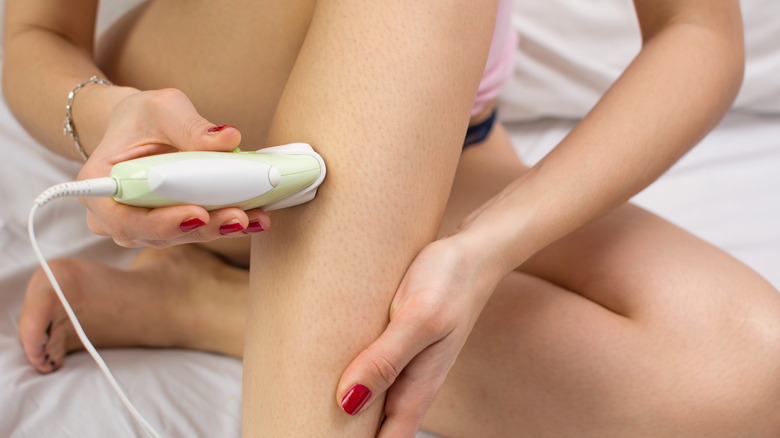Epilating Vs. Waxing: What's The Difference, And Which Is Right For You?
To remove or not to remove — that's a question many of us have about body hair. Hair removal is often laborious and expensive, with surveys noting that women, on average, spend over $10,000 and nearly 60 days on hair removal products and services in their lives. That's a lot of money and days you'll never get back.
Hair removal is, of course, optional, but those who prefer to have clear underarms, legs, and crotches must be smart about how they choose to get rid of their unwanted body hair. If laser or permanent removal is out of the question, you're left with other less expensive options: shaving, depilatory or hair removal creams, tweezing, threading, waxing, and epilating. The first two methods are the fastest, which means hair grows back quicker. The following two are known to be the most painful options since they require taking out the hair from the roots one by one. And so you're left with the last two, waxing and epilating, which many prefer anyway because hair grows back in weekly intervals.
Waxing and epilating are hair removal methods you can do on your own with the right tools, but what is the difference between the two? And is one better than the other?
The difference between waxing and epilating
Waxing and epilating are similar in more ways than you think. Both hair removal methods extract hair straight from the root, and the results last three to four weeks on average. The pain level is more or less the same as well. But one of their key differences is waxing is typically done manually, whereas epilating requires using an electronic tool called, well, an epilator.
With waxing, you apply a warm goop on your skin that functions as an adhesive for the hair and then yank it all out with a paper strip. This method is more laborious since you need to heat the wax and trim hair a bit when they're past the recommended length. The rule of thumb is to ensure that the hairs are around a quarter of an inch to be successfully pulled from the root.
On the other hand, with epilating, you don't have to trim or wait until the hairs are long enough to perform hair removal. Epilators are usually capable of targeting the follicle regardless of hair length. "Epilators use a rotating barrel and tweezing mechanic to pull unwanted hair from the root, unlike shaving, which simply cuts the hair at skin level," Nicole Wedderburn, Remington brand manager, told Elle UK of the method. "The barrel is covered in tweezers, and as it rotates, the epilator plucks the hairs to leave your skin smooth and hair free."
How to choose what's right for you
Deciding between waxing and epilating all boils down to your budget, pain tolerance, and patience. With waxing, you may do it on your own to save money, but you can also prefer to have a professional do it for you, which may dent your wallet. But waxing is also relatively quick, whereas, with epilating, you may have to run the epilator through the area multiple times. That means the time you'll be feeling discomfort can also be longer. To combat this, dermatologist Dr. Anita Sturnham told Cosmopolitan that using warm water is ideal. "The warmth of the water releases endorphins, which helps to reduce any discomfort or irritation. If you've tweezed or waxed, it's a similar feeling," she said.
Epilating can also cost a lot, depending on what type of device you choose. The best epilators on the market can run you over $100, but the good news is you only have to pay once, and you're good to go. With waxing, you must either keep booking appointments or buy wax strips yourself.
It's worth noting, however, that epilating can cause ingrown hairs, so you may want to consider that before investing in a device. On the other hand, waxing is a form of exfoliation and can even make your skin appear brighter. "When the wax is pulled from the skin, it takes the dead surface cells away with it," board-certified dermatologist Geeta Yadav told Byrdie.


